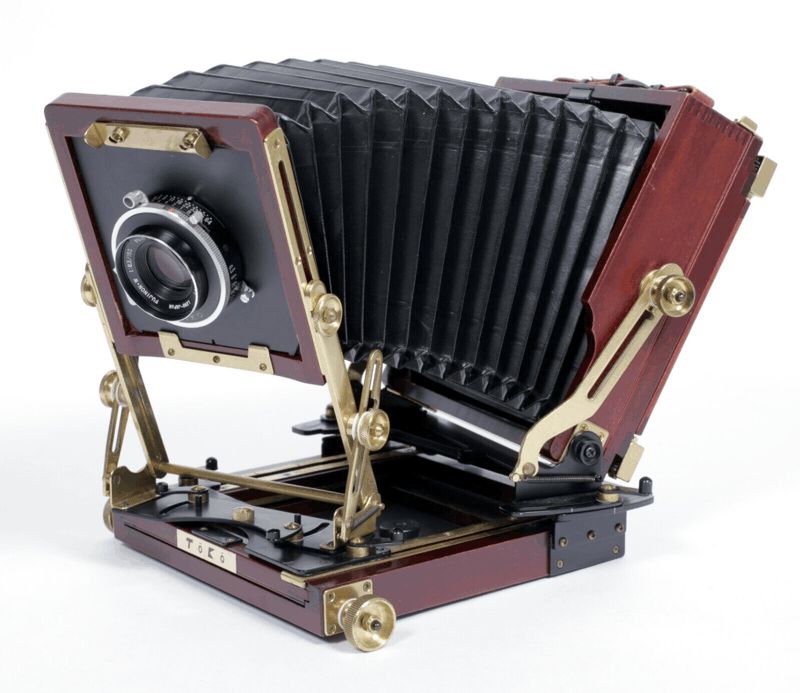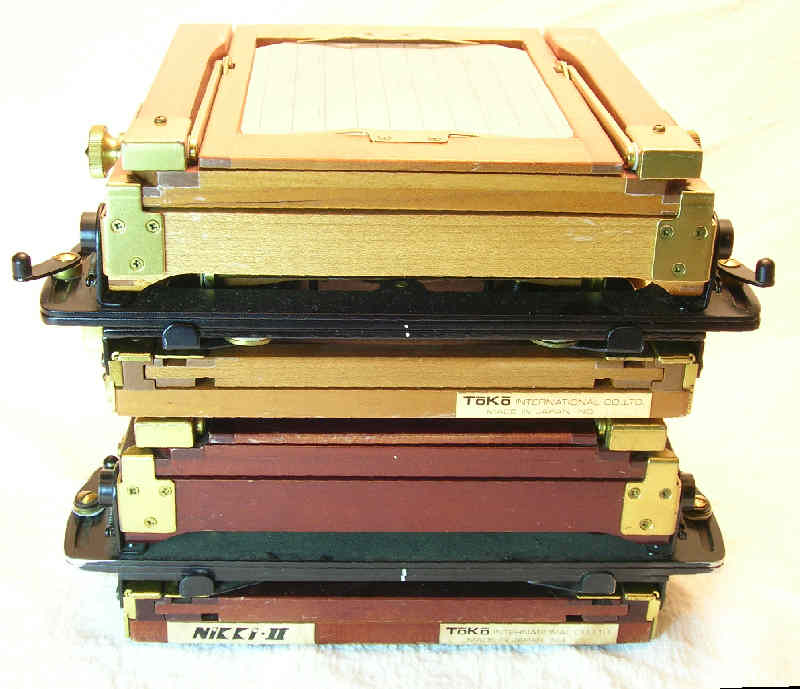![[IMAGE OF TOKO LITERATURE]](toko.jpg)
The Nikki cameras can usually be identified by having a brass plate on the rear of the base that says "TOKO INTERNATIONAL" along with a serial number (see sample below) -- probably starting with a "0". There is also probably another plate -- on the front or the rear that says "NIKKI".
Nikki I
The 1985 Buyer's Guide from Popular Photography lists a Toko Nikki I, a Nikki II and a Nikki III. The Nikki I is the least expensive, with the least features -- but not by much (see comparison table below). It lacks the back focus movement of the Nikki II, so it has a shorter bellows -- 300mm (12") -- so it was less expensive and subsequently weighs less -- 1.6kg (3.5 lbs.). What long lenses you can use depends on the flange focal length of the lens. With standard lenses that have a flange local length nearly identical to the optical focal length you can only use a 300mm lens -- and only at infinity. However there are long focal length lenses that have a telephoto design with a shorter flange focal length, such as the Fujinon 400mm f8.0 T lens with a flange focal length of 252mm. This allows you to focus much closer than infinity. However, true telephoto lenses are large and heavy. With wide-angle lenses, it again depends on the flange focal length. Most wide angle lenses have a flange focal length that is longer than the optical focal length so you might be able to use the lens directly. For example, the flange focal length of the Fujinon 65mm f5.6 SWD is 73mm. The Nikki I allows you to use lenses with a flange focal length as short as 65mm, directly, or even shorter with a change or two. Depending on the angle of view/picture angle of the lens, and your need for swings and shifts and rise/fall you might need to drop the bed to avoid vignetting. Another option is a recessed lens board. With one or both of these approaches, you can even use a lens as short as 47mm!
Otherwise, the features are exactly the same as the Nikki II. Some, and perhaps all, of the Nikki I cameras have a latch on top to close it. On later models this may be replaced by a magnet. Remember, these cameras are hand made so individual variation is very possible.

Nikki II
The Toko Nikki II adds rear focus to the Nikki I so you can extend the
back backward -- 60mm (2.4") -- or move it forward -- 50mm (2"). This allows
you to set the total bellows extension anywhere from 65mm to 360mm (14 inches).
It also lets you use super-wide-angle lenses - even without a recessed lensboard
and without having to drop the camera bed -- as well as using longer focal
length lenses such as 300mm and 360mm lenses - and even 400mm telephoto lenses.
With a recessed lensboard you are even able to use extra-super-wide-angle
lenses such as the 47mm Schneider XL and with extension cones you can use
some 600mm lenses.
Both cameras have substantial rise and fall on the front standard (75mm up
or down) as well as left and right swings (20 degrees left and right) and
backward and forward tilts (90 degrees forward and 20 degrees back). Neither
has shift on the front standard. On the rear standard both have left and
right shift (20mm left and right) and left and right swings (12 degrees left
and right) and backward and forward tilts (28 degrees backward and 20 degrees
forward). There is no rise and fall on the rear standard.
The front standard took Wista or Linhof type lensboards but the shutter hole is purposely placed off-center -- about 10mm lower than dead center. The rear standard is a standard, universal spring back accepting 4x5 sheet film holders, Polaroid film packs and holders, 6x7 and 6x9 roll film holders, and even 5x7 film with an adapter back.
![[BLANK SPACE FOR FUTURE IMAGE OF TOKO CAMERA]](nikki300.jpg)
Nikki III
There is no evidence that this camera ever existed. It only appears in the Popular Photography listing -- no photograph or details. Who knows if is a typo on the part of Popular Photography or if it was listed, by mistake, in the information that Popular Photography received. In any event, it is hard to image what additional features could have been added to the Nikki II.
You can identify the model that you have in a couple of ways. If it's an FL model it will have a TOKO plate on the front. There is no "FL" marked anywhere. If it's a NIKKI model it will have a NIKKI plate on the front or rear. The Nikki I and the FL-451 both lack rear focus. The Nikki II and the FL-452 both have rear focus. Here is a shot of the two backs.

Otherwise, you are on your own -- but the FL model serial numbers probably start with a "B", although it might be hard to see!
COPYRIGHT@1995-2023 by Joe McGloin.
All Rights Reserved.
The material on this website is protected by US Federal copyright laws. It
cannot be copied or used in any manner without specific approval from the
owner.